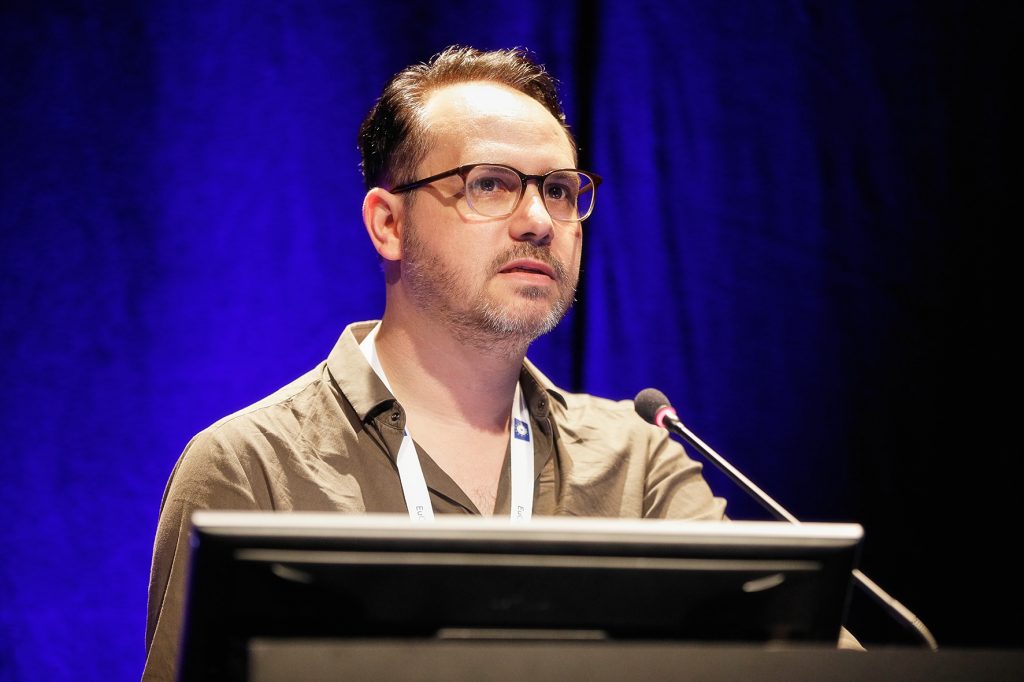DMEK vs DSAEK studies continue

Dermot McGrath
Published: Friday, April 3, 2020
 Mor Dickman, MD, PhD[/caption]
Descemet Membrane Endothelial Keratoplasty (DMEK) and ultrathin Descemet Stripping Automated Endothelial Keratoplasty (UT-DSAEK) achieved broadly similar visual outcomes but with a higher complication rate for DMEK, according to the results of a multi-centre randomised controlled trial presented at the 10th EuCornea congress.
“We found no significant difference in mean postoperative visual acuity one year after surgery, although a higher proportion of DMEK patients attained better visual acuity. The endothelial cell loss was comparable after both techniques, stabilising after three months. However, there were more complications following DMEK in terms of re-bubbling and re-grafts,” said Mor Dickman MD, PhD, University Eye Clinic, Maastricht University Medical Center, Netherlands, who presented the study outcomes.
Dr Dickman noted that DMEK procedures have been steadily increasing in recent years in both the US and Europe. Data from the Eye Bank Association of America showed that there was a slight decrease in DSAEK numbers in each of the past three years, whereas DMEK increased 64% in 2015 and 37.6% in 2016.
“All the data shows that DMEK procedures are increasing while DSAEK remains more or less the same, so this means we are operating more, and that the threshold to operate has decreased,” he said.
Reported advantages
Carried out at six clinics in the Netherlands, the prospective randomised study compared best-corrected visual acuity, endothelial cell density and complications after DMEK and UT-DSAEK in 54 eyes of 54 patients with Fuchs’ endothelial corneal dystrophy (FECD).
“We really wanted to assess the reported advantages of DMEK versus those of UT-DSAEK. DMEK is widely considered to offer better visual recovery, less graft rejections, potentially shorter surgery time and a neutral refractive procedure. The perceived advantages of UT-DSAEK, at least when one has good experience with the technique, are less graft detachments and less graft failures, a short learning curve, and it works well in complex eyes,” he said.
The study included patients with FECD, 21 years or older who had already undergone cataract surgery. Only one eye was treated in the study and all grafts were pre-cut and pre-stripped from the same eye bank. Preoperative visual acuity, age and donor endothelial cell density were closely matched for both treatment arms.
There was no statistically significant difference in mean postoperative visual acuity between DMEK and UT-DSAEK after 12 months follow-up. However, a higher proportion of DMEK patients attained better visual acuity outcomes, said Dr Dickman.
Patients treated with DMEK also experienced faster recovery of contrast sensitivity and straylight symptoms, while there was no statistical difference in total corneal aberrations or vision-related quality of life outcomes. The results of a cost-effectiveness analysis comparing both techniques are expected next year.
Mor Dickman: mor.dickman@mumc.nl
Mor Dickman, MD, PhD[/caption]
Descemet Membrane Endothelial Keratoplasty (DMEK) and ultrathin Descemet Stripping Automated Endothelial Keratoplasty (UT-DSAEK) achieved broadly similar visual outcomes but with a higher complication rate for DMEK, according to the results of a multi-centre randomised controlled trial presented at the 10th EuCornea congress.
“We found no significant difference in mean postoperative visual acuity one year after surgery, although a higher proportion of DMEK patients attained better visual acuity. The endothelial cell loss was comparable after both techniques, stabilising after three months. However, there were more complications following DMEK in terms of re-bubbling and re-grafts,” said Mor Dickman MD, PhD, University Eye Clinic, Maastricht University Medical Center, Netherlands, who presented the study outcomes.
Dr Dickman noted that DMEK procedures have been steadily increasing in recent years in both the US and Europe. Data from the Eye Bank Association of America showed that there was a slight decrease in DSAEK numbers in each of the past three years, whereas DMEK increased 64% in 2015 and 37.6% in 2016.
“All the data shows that DMEK procedures are increasing while DSAEK remains more or less the same, so this means we are operating more, and that the threshold to operate has decreased,” he said.
Reported advantages
Carried out at six clinics in the Netherlands, the prospective randomised study compared best-corrected visual acuity, endothelial cell density and complications after DMEK and UT-DSAEK in 54 eyes of 54 patients with Fuchs’ endothelial corneal dystrophy (FECD).
“We really wanted to assess the reported advantages of DMEK versus those of UT-DSAEK. DMEK is widely considered to offer better visual recovery, less graft rejections, potentially shorter surgery time and a neutral refractive procedure. The perceived advantages of UT-DSAEK, at least when one has good experience with the technique, are less graft detachments and less graft failures, a short learning curve, and it works well in complex eyes,” he said.
The study included patients with FECD, 21 years or older who had already undergone cataract surgery. Only one eye was treated in the study and all grafts were pre-cut and pre-stripped from the same eye bank. Preoperative visual acuity, age and donor endothelial cell density were closely matched for both treatment arms.
There was no statistically significant difference in mean postoperative visual acuity between DMEK and UT-DSAEK after 12 months follow-up. However, a higher proportion of DMEK patients attained better visual acuity outcomes, said Dr Dickman.
Patients treated with DMEK also experienced faster recovery of contrast sensitivity and straylight symptoms, while there was no statistical difference in total corneal aberrations or vision-related quality of life outcomes. The results of a cost-effectiveness analysis comparing both techniques are expected next year.
Mor Dickman: mor.dickman@mumc.nl